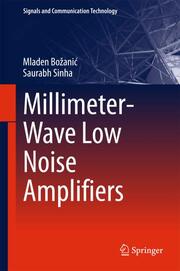Detailansicht
Millimeter-Wave Low Noise Amplifiers
Signals and Communication Technology
ISBN/EAN: 9783319690193
Umbreit-Nr.: 2832425
Sprache:
Englisch
Umfang: xviii, 334 S., 218 s/w Illustr., 46 farbige Illust
Format in cm:
Einband:
gebundenes Buch
Erschienen am 22.11.2017
Auflage: 1/2018
- Zusatztext
- This book is the first standalone book that combines research into low-noise amplifiers (LNAs) with research into millimeter-wave circuits. In compiling this book, the authors have set two research objectives. The first is to bring together the research context behind millimeter-wave circuit operation and the theory of low-noise amplification. The second is to present new research in this multi-disciplinary field by dividing the common LNA configurations and typical specifications into subsystems, which are then optimized separately to suggest improvements in the current state-of-the-art designs. To achieve the second research objective, the state-of-the-art LNA configurations are discussed and the weaknesses of state-of the art configurations are considered, thus identifying research gaps. Such research gaps, among others, point towards optimization - at a systems and microelectronics level. Optimization topics include the influence of short wavelength, layout and crosstalk on LNA performance. Advanced fabrication technologies used to decrease the parasitics of passive and active devices are also explored, together with packaging technologies such as silicon-on-chip and silicon-on-package, which are proposed as alternatives to traditional IC implementation. This research outcome builds through innovation. Innovative ideas for LNA construction are explored, and alternative design methodologies are deployed, including LNA/antenna co-design or utilization of the electronic design automation in the research flow. The book also offers the authors' proposal for streamlined automated LNA design flow, which focuses on LNA as a collection of highly optimized subsystems.
- Kurztext
- This book examines the challenges of low-noise amplifier (LNA) research and design in the millimeter-wave regime by dissecting the common LNA configurations and typical specifications into parts, which are then optimized separately over several chapters to suggest improvements in the current designs. Current trends towards increased wireless connectivity and the need to stay connected everywhere and all the time, call for extremely high data rates. Most of the wireless networks operate in frequency bands measured in low gigahertz. Typically, this is done through channels with moderate bandwidth. To keep up with the trends for increased data transmission rates, new and innovative ideas are needed. One of the areas of investigation is the transmission in millimeter-wave regime, ranging from 30 GHz to 300 GHz, where there is an abundance of bandwidth. The low-noise amplifier (LNA) is the first component that appears in the front ends of most microwave and millimeter-wave receivers after an antenna. The performance of a millimeter-wave receiver is therefore largely dependent on the performance of the LNA that is used. Primarily, the LNA is tasked with amplifying a signal while introducing as little noise into the signal as possible. This is a necessity, because the signal received by the antenna is already submerged in noise, thus the signal, before it can be processed, needs to be amplified with the smallest possible amount of additional noise introduced in this process. This is even more so true, due to the limitation of the wave propagation in millimeter-wave regime, where there is a trade-off between data-rate, range and power.
- Autorenportrait
- Saurabh Sinha is full professor of Electronics at the University of Johannesburg, South Africa, where he has been Executive Dean of the Faculty of Engineering and Built Environment since 2013. In addition he is the managing editor of the South African Institute of Electrical Engineers (SAIEE) Africa Research Journal.
